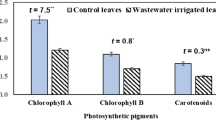Abstract
Four crop plants Oryza sativa (rice), Solanum melongena (brinjal), Spinacea oleracea (spinach) and Raphanus sativus (radish) were grown to study the impact of secondary treated municipal waste water irrigation. These plants were grown in three plots each of 0.5 ha, and irrigated with secondary treated waste water from a sewage treatment plant. Sludge from the same sewage treatment plant was applied as manure. Cultivated plants were analyzed for accumulation of heavy metals and pesticides. Results revealed the accumulation of six heavy metals cadmium (Cd), chromium (Cr), iron (Fe), copper (Cu), nickel (Ni), and zinc (Zn) as well as two pesticides [1,1-bis(p-chlorophenyl)-2,2,2-trichloroethane; DDT] and benzene hexa chloride (BHC). Order of the plants for the extent of bioaccumulation was S. oleracea > R. sativus > S. melongena > O. sativa. The study has shown the secondary treated waste water can be a source of contamination to the soil and plants.
Similar content being viewed by others
References
Abollino, O., Aceto, M., Malandrino, M., Mentasti, E., Sarzanini, C., & Petrerra, F. (2002). Heavy metals in agricultural soils from Piedmont, Italy. Distribution, speciation and chemometric data treatment. Chemosphere, 49, 545–557. doi:10.1016/S0045-6535(02)00352-1.
Antoniadis, V., & Alloway, B. J. (2002). The role of dissolved organic carbon in the mobility of Cd, Ni and Zn in sewage sludge-amended soils. Environmental Pollution, 117, 515–521. doi:10.1016/S0269-7491(01)00172-5.
APHA (1995). Standard methods for examination of water and waste water. Washington, DC: American Public Health Association, American Water Works Association, and Water Pollution Control Federation.
Appel, C., & Ma, L. (2002). Concentration, pH, and surface charge effects on cadmium and lead sorption in three tropical soils. Journal of Environmental Quality, 31, 581–589.
Asthana, D. K., & Asthana, M. (2003). Environment-problems & solutions. Ramnagar, New Delhi: Chand and Company.
Baghour, M., Moreno, D. A., Hernandez, J., Castilla, N., & Romero, L. (2001). Influence of root temperature on phytoaccumulation of As, Ag, Cr and Sb in Potato plants (Solanum tuberosum). Journal of Environmental Science and Health. Part A, 36, 1389–1401. doi:10.1081/ESE-100104886.
Bergkvist, P., Berggren, D., & Jarvis, N. (2005). Cadmium solubility and sorption in a long-term sludge-amended arable soil. Journal of Environmental Quality, 34, 1530–1538. doi:10.2134/jeq2004.0385.
Blanchard, M., Teil, M. J., Ollivon, D., Garban, B., Chesterikoff, C., & Chevreuil, M. (2001). Origin and distribution of polyaromatic hydrocarbons and polychlorophenyls in urban effluents to wastewater treatment plants of the Paris area (France). Water Research, 5, 3679–3687. doi:10.1016/S0043-1354(01)00078-1.
Campbell, C. A., & Plank, C. O. (1998). Preparation of plant tissue for laboratory analysis. In Y. P. Kalara (Ed.), Handbook of reference methods for plant analysis. Boca Raton: CRC Press.
Dash, A. P., Raghavendra, K., & Pillai, M. K. K. (2007). Resurrection of DDT: A critical appraisal. The Indian Journal of Medical Research, 126, 1–3.
Devkota, B., & Schmidt, G. H. (2000). Accumulation of heavy metals in food plants and grasshoppers from the Taigetos Mountains, Greece. Agriculture Ecosystems & Environment, 78, 85–91. doi:10.1016/S0167-8809(99)00110-3.
Ekvall, L., & Greger, M. (2003). Effects of environmental biomass producing factors on Cd uptake in two Swedish ecotypes of Pinus sylvestris. Environmental Pollution, 121, 401–411. doi:10.1016/S0269-7491(02)00232-4.
Ellis, D. R., & Salt, D. E. (2003). Plants, selenium and human health. Current Opinion in Plant Biology, 6, 273–279. doi:10.1016/S1369-5266(03)00030-X.
Fotovat, A., Naidu, R., & Sumner, M. E. (1997). Water:soil ratio influences aqueous phase chemistry of indigenous copper and zinc in soils. Australian Journal of Soil Research, 35, 687–710. doi:10.1071/S96086.
Itanna, F. (2002). Metals in leafy vegetables grown in Addis Ababa and toxicological implications. Ethiopian Journal of Health Development, 6, 295–302.
Jackson, M. L. (1962). Soil chemical analysis (pp. 183–190). Englewood Cliffs, NJ: Prentice-Hall.
Korboulewsky, N., Bonin, G., & Massiani, C. (2002). Biological and ecophysiological reactions of white wall rocket (Diplotaxis erucoides L.) grown on sewage sludge compost. Environmental Pollution, 17, 365–370. doi:10.1016/S0269-7491(01)00165-8.
Mader, S. S. (1996). Biology—5th ed. WCB, Cox, G.W. Conservation Biology—2nd ed. WCB.
Mapanda, F., Mangwayana, E. N., Nyamangara, J., & Giller, K. E. (2005). The effect of long-term irrigation using wastewater on heavy metal contents of soils under vegetables in Harare, Zimbabwe. Agriculture Ecosystems & Environment, 107, 151–165. doi:10.1016/j.agee.2004.11.005.
Martinez, C. E., & Motto, H. L. (2000). Solubility of lead zinc and copper added to mineral soils. Environmental Pollution, 107, 153–158. doi:10.1016/S0269-7491(99)00111-6.
McBride, M., Sauve, S., & Hendershot, W. (1997). Solubility control of Cu, Zn, Cd and Pb in contaminated soils. European Journal of Soil Science, 48, 337–346. doi:10.1111/j.1365-2389.1997.tb00554.x.
Mitra, J., Mukherjee, P. K., Kale, S. P., & Murthy, N. B. K. (2001). Bioremediation of DDT in soil by genetically improved strains of soil fungus Fusarium solani. Biodegradation, 12, 235–245. doi:10.1023/A:1013117406216.
Moreno, D. A., Villora, G., Soriano, M. T., Nicols, C., & Luis, R. (2005). Sulfur, chromium, and selenium accumulated in Chinese cabbage under direct covers. Journal of Environmental Management, 74, 89–96. doi:10.1016/j.jenvman.2004.08.011.
Nan, Z., Li, J., Zhang, C., & Cheng, G. (2002). Cadmium and zinc interaction and their transfer in soil–crop system under actual field conditions. The Science of the Total Environment, 285, 187–195. doi:10.1016/S0048-9697(01)00919-6.
Nelson, D. W., & Sommers, L. E. (1996). Total carbon, organic carbon, and organic matter. In D. L. Sparks (Ed.), Methods of soil analysis. Part 3: Chemical methods (pp. 961–1010). Madison, WI: Soil Sci. Soc. Am.
Peach, K., & Tracey, M. V. (1956). Modern methods of plant analysis (Vol.-1). Berlin: Springer.
Rengasamy, P., Chittleborough, D., & Helyar, K. (2003). Root-zone constraints and plant-based solutions for dryland salinity. Plant and Soil, 257, 249–260. doi:10.1023/A:1027326424022.
Singh, K. P., Mohan, D., Sinha, S., & Dalwani, R. (2004). Impact assessment of treated/untreated wastewater toxicants discharge by sewage treatment plants on health, agricultural, and environmental quality in wastewater disposal area. Chemosphere, 55, 227–255. doi:10.1016/j.chemosphere.2003.10.050.
USEPA (2001a). Microwave assisted digestion of sediments, sludges, soils and oils. Official methods/ US EPA methods. Method, 3051, 846.
USEPA (2001b). Microwave assisted acid digestion of siliceous materials. Official methods/ US EPA methods. Method, 3051a, 846.
Wang, C. X., Wang, Y., Kiefer, F. Y. A., Wang, Z. J., & Kettrup, A. (2003). Ecotoxicological and chemical characterization of selected treatment process effluents of municipal sewage treatment plant. Ecotoxicology and Environmental Safety, 56, 211–217. doi:10.1016/S0147-6513(02)00121-5.
Author information
Authors and Affiliations
Corresponding author
Rights and permissions
About this article
Cite this article
Mishra, V.K., Upadhyay, A.R. & Tripathi, B.D. Bioaccumulation of heavy metals and two organochlorine pesticides (DDT and BHC) in crops irrigated with secondary treated waste water. Environ Monit Assess 156, 99–107 (2009). https://doi.org/10.1007/s10661-008-0466-4
Received:
Accepted:
Published:
Issue Date:
DOI: https://doi.org/10.1007/s10661-008-0466-4




